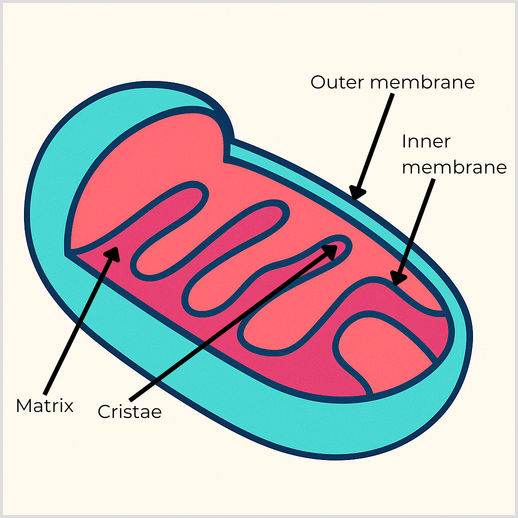Respiration is an exothermic reaction in living organisms, from bacteria to human beings and plants. It is a vital chemical process that happens in every cell of the organism. Respiration releases energy when glucose is converted into adenosine triphosphate (ATP). It is essential for growth, movement and digestion.
This article explains the chemical reactions of aerobic, anaerobic and cellular respiration. We will explore the significance of each and their applications to the world around us. This article is aimed at students preparing for their GCSE Biology examinations and is suitable for all major exam boards, including AQA and Edexcel. Quiz questions are included to test your knowledge.
If you need help learning this topic, TeachTutti has qualified GCSE Biology tutors who can support your revision, such as by preparing GCSE revision notes.
Cellular respiration
Cellular respiration is a biological process that happens inside the living cells of all living organisms. The process converts the chemical energy in food molecules into a form of energy called adenosine triphosphate or ATP. The energy transferred supplies all the energy needed for living processes.
These food molecules are most commonly glucose, which is a simple sugar. ATP is the "energy currency" of a cell: all living cells require energy and therefore use ATP to power processes like muscle contraction, nerve impulse transmission and the synthesis of essential molecules.
Respiration happens largely inside specialised structures called mitochondria. This is an organelle (a subcellular structure with specific jobs for its cell) that is the "powerhouse" of the cell, due to its importance in creating energy. They have a unique structure, containing an inner membrane that folds extensively to create cristae. These folds boost the organelle's efficiency by dramatically increasing the surface area for respiration reactions.
There are two main types of cellular respiration:
- Aerobic respiration - Aerobic respiration requires oxygen and creates large amounts of ATP. It breaks down glucose to produce carbon dioxide and water. This respiration takes place continuously in living organisms because it is so efficient.
- Anaerobic respiration - This occurs when there is limited oxygen or even without oxygen. Anaerobic respiration breaks down glucose into lactic acid in animals, while it converts it into ethanol and carbon dioxide in yeast and some plants. Less ATP is created anaerobically; it's a temporary, less efficient solution when oxygen is limited.

Cellular respiration means that you can only transfer energy from one form to another. It can't be created or destroyed. The chemical energy in glucose turns into ATP, while respiration releases heat energy as a byproduct. This is an example of the universality of energy principles.
1
What is the purpose of cellular respiration?
Aerobic respiration
Aerobic respiration needs the presence of oxygen. It completely breaks down glucose to release a huge amount of energy. It is very efficient and creates far more ATP compared to anaerobic respiration. It occurs continuously in most organisms to meet their energy demands. This includes plants, animals and humans.
This is the word equation for aerobic respiration:
Glucose + Oxygen -> Carbon dioxide + Water + Energy (ATP)
This is the respiration expressed as a balanced chemical equation:
C6H12O6 + 6O2 -> 6CO2 + 6H2O + Energy (ATP)
There are multiple stages to the chemical breakdown of glucose. Each stage releases energy captured by ATP molecules. At the start, the glucose is partially broken down into the cytoplasm (glycolysis). This continues inside mitochondria, where the glucose goes through a cycle of reactions called the Krebs cycle. This is followed by the electron transport chain, which significantly increases ATP production.
One molecule of glucose can generate approximately 38 ATP molecules (although normally 30-32 ATP molecules are yielded due to inefficiencies in cellular conditions). This support sustains activity and allows the organism to maintain bodily functions, including cell growth, muscle contractions and nerve impulses.
The byproducts of aerobic respiration are carbon dioxide and water. These are expelled as waste: C02 is removed through the respiratory system (breathing), while water is either used inside the organism or excreted.
2
What is the word equation for aerobic respiration?
Anaerobic respiration
Anaerobic respiration is a fallback solution when there is little to no available oxygen. This method is less effective and involves the incomplete breakdown of glucose, resulting in less energy. It only happens in specific conditions, such as in the muscles after an exhausting workout or inside microorganisms, like yeast.
There are two common forms:
1. Anaerobic Respiration in animals
This form of respiration is found in animals, including humans. When we engage in vigorous physical activity, muscles need more energy than the available oxygen can sustain. When this happens, cells switch to anaerobic respiration and produce lactic acid molecules.
This is the word equation:
Glucose -> Lactic acid + Energy (ATP)
Lactic acid accumulates in muscles. It creates fatigue, soreness and temporary muscle pain. When oxygen becomes available when we rest, lactic acid is converted into harmless substances.
2. Anaerobic Respiration in Microorganisms
Microorganisms like yeast use anaerobic respiration in environments lacking oxygen. This is called fermentation. It is used in baking and brewing.
This is the word equation for yeast fermentation:
Glucose -> Ethanol + Carbon dioxide + Energy (ATP)
Carbon dioxide helps dough rise in baking, while ethanol is needed to brew alcoholic drinks.
Anaerobic respiration creates less ATP, producing about 2 ATP molecules per glucose molecule. It is much less efficient and is only a temporary energy production method.
3
What is a product of anaerobic respiration in human muscles?
Comparing aerobic and anaerobic respiration
It is important to understand why aerobic respiration is the preferred energy production method for organisms and the circumstances where anaerobic respiration occurs. The table below compares their key differences:
| Feature | Aerobic Respiration | Anaerobic Respiration |
| Oxygen required? | Yes | No |
| Energy produced | High (approximately 30-32 ATP per glucose) | Low (approximately 2 ATP per glucose) |
| End products | Carbon dioxide and water | Lactic acid in animals, ethanol and CO2 in yeast |
| Efficiency | Very efficient, ideal for sustained energy needs | Low efficiency, suitable for short-term energy demands |
| Occurrence | Continuous in most organisms | Temporary in animals or for specific organisms/environments, such as yeast |
Aerobic respiration is more effective at turning chemical energy into ATP and is ideal for continuous activities. Anaerobic respiration is less efficient and provides limited energy for short bursts of activity - such as intensive exercise - or in environments lacking oxygen.
4
Which statement comparing aerobic and anaerobic respiration is correct?
Measuring respiration rates
We can measure the rate of respiration in organisms. A common method is to measure the amount of carbon dioxide produced or the oxygen consumed during respiration. You can set up a laboratory to include a sealed container and a gas syringe or a carbon dioxide sensor. A typical organism to test could be yeast or germinating seeds. You can find the respiration rate by tracking changes in gas volume over a period of time.
Example method
- Setup - Put the seeds or yeast into a lead container. Ensure it's connected to a gas syringe or a C02 sensor. The temperature needs to be consistent for accuracy.
- Measurement - Check the gas production at regular intervals, such as every minute. Recording the concentration of gas that is produced.
- Analysis - Plot a graph that displays the volume of gas produced against time. The slope of this graph will show the rate of respiration.
Accuracy, precision and rate calculations are vital in respiration experiments. For example, a temperature change can cause variations in enzyme activity and affect the results.
5
In a graph showing gas volume versus time for a respiration experiment, what does the slope tell us?
Real-world applications
Respiration is vital to our world and the animals that occupy it. We have explored some of these daily phenomena, from sports to baking.
Sports and exercise physiology
Understanding respiration is crucial to the success of athletes, coaches and sports scientists. Muscles often change from aerobic to anaerobic respiration during intense exercise, due to insufficient oxygen. This switch creates lactic acid, creating discomfort and tiredness. A knowledge of this helps athletes to train effectively, refining their routines to enhance oxygen efficiency, delay fatigue and boost recovery.
Food production: baking and brewing
Yeast fermentation is integral to making bread and alcoholic drinks. Yeast ferments sugar, which creates carbon dioxide and ethanol. In baking, carbon dioxide creates air pockets, which allow the dough to rise and become fluffy. Meanwhile, when brewing, ethanol is the alcohol present in drinks like beer and wine.
Environmental and agricultural science
Keeping track of the respiration rates in plants and seeds helps farmers and gardens to maintain their health, growth and metabolic activity. Harvested crops need to be stored according to their respiration rates. For example, a lower respiration preserves freshness and extends shelf-life.
Medical diagnostics
Medical professionals rely on respiration rates and patterns for insights into the health of their patients. High respiration rates or unusual breathing patterns can point to medical issues, such as an underlying condition, metabolic disorders, or a breathing disease. Monitoring respiration rates can advance diagnosis and treatment.
6
What does anaerobic respiration contribute to baking?
Conclusion on Respiration - GCSE Biology
Respiration converts glucose into usable energy using the mitochondria organelles. It is a crucial biological process that underpins life itself. We have explored the two types: aerobic and anaerobic respiration. Aerobic respiration efficiently supports sustained activity, while anaerobic respiration provides a quick burst of energy when oxygen is limited. We have explored word equations for these respiration processes, methods to measure respiration rates and real-world applications.
For further reading, you can read the BBC Bitesize article explaining adenosine triphosphate (ATP) in more detail. You can also test yourself with past paper questions on respiration by SaveMyExams.
If you need more support learning about respiration, TeachTutti has vetted Biology GCSE tutors who can teach you online or in person. Every tutor has an enhanced DBS check and will tailor lessons to your individual needs.
This post was updated on 10 Jul, 2025.

